Jesus Once Was a Little Child / Little Purple Pansies / Oh, Hush Thee, My Baby [Christmas Cradle Song] / Shine On / Stand For the Right
Joseph Ballantyne (1868-1944) was an early twentieth-century Latter-day Saint composer. His compositions have featured prominently in the various primary and Sunday school songbooks published by the Church over the past century, but he is not as well-known today as some of his contemporaries. This is probably because most of his songs were written for children. In addition, none of his compositions have ever been included in the official Church hymnal (at least in the English language hymnal; some of his pieces have appeared in foreign language editions). Ballantyne is credited with five songs in the most recent primary collection, The Children’s Songbook (1989).
Jesus Once Was a Little Child
Text: James R. Murray, 1880
Music: Joseph Ballantyne, 1905
“Jesus Once Was a Little Child” is undoubtedly the best-known of Ballantyne’s compositions. The words were written by James R. Murray (1841-1905), a nineteenth-century gospel song composer who is remembered today primarily for composing the tune MUELLER for “Away in a Manger” in 1887. [1] The words of “Jesus Once Was a Little Child” were first published in Murray’s Royal Gems: A New and Choice Collection of Sunday School Songs (Cleveland, 1880), and consisted of three stanzas of eight lines each, and a chorus. [2] The original musical setting was also composed by Murray, and the song’s original title was “Jesus Once Was A Little Child (A song for the little ones).” The following is the original text:
- Jesus once was a little child,
A little child like me,
And he was pure and meek and mild,
As a little child should be;
He play’d as little children play,
The pleasant games of youth,
But he never got vex’d if the game went wrong,
And he always spoke the truth.
Chorus:
So, little children, let’s you and I
Try to be like him, try, try, try.
- Jesus once was a little child,
And he grew like children do,
While his mother taught him lovingly,
To be gentle, kind and true;
Over the fields of Bethlehem,
With playmates he did roam,
But he never would fret and scold and pout
When his mother call’d him home.
- Jesus once was a little child,
He came to us to show
The way to his pure, sweet life above,
From our sinful life below;
We must be, and do, and love like him.
Be kind, all evil shun,
And he’ll bring us all to his heav’nly home,
When our life-work is done.
When Joseph Ballantyne set Murry’s words to music, he used only the first stanza of the original text. However, he divided it in half, creating two new stanzas of four lines each, to which he added the words of Murray’s original chorus. This is the version of the text found in The Children’s Songbook today. Ballantyne’s tune was first published in The Primary Song Book (1905). [3]
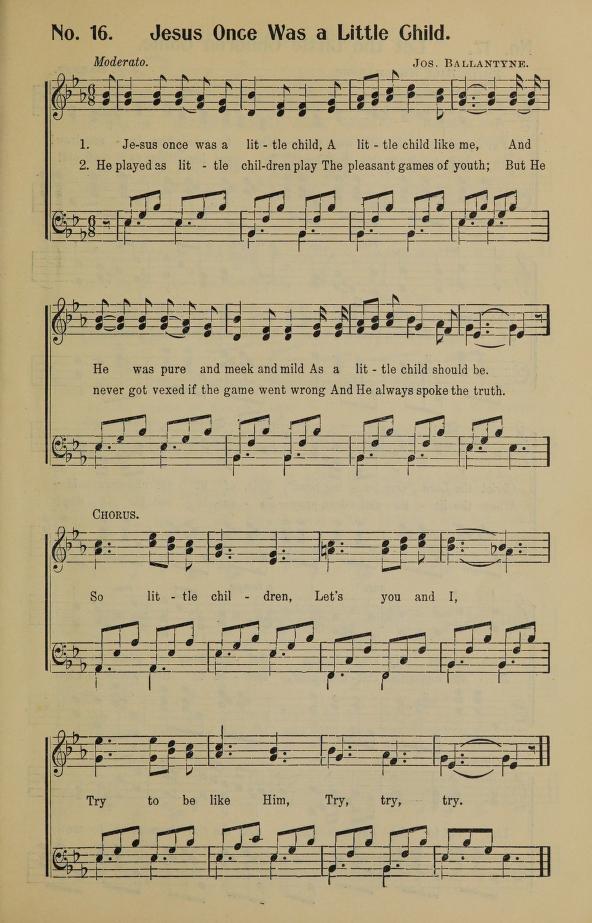
As biographical information concerning Murray is scarce, even in this information-rich internet age, a brief biographical sketch seems warranted. See notes at the end. [4]
Little Purple Pansies
Text: Alice E. Allen, 1899
Music: Joseph Ballantyne, 1907
“Little Purple Pansies” is rarely sung today, but it was once quite popular with members of the Church of Jesus Christ of Latter-day Saints. In The Children’s Songbook (1989), the words of this song are credited as “Anon.,” but when they were first published in September 1899 in the periodical Primary Education, they were signed “A. E. A.” [5]

Originally, the identity of “A. E. A.” was not known. However, shortly after this post was published, Samuel Bradshaw, at Singpraises.net, discovered several poems and stories in Primary Education under the name Alice E. Allen, and after some investigation it appears that Alice E. Allen and “A. E. A.” are one and the same.
Alice E Allen (1870-1960) was born in Constableville, New York in August 1870. Her parents were Charles M. Allen (1845-1924) and Nancy Miller Pease (1844-1904). Alice moved to Lowville, New York, at age eighteen and taught school for eight years at the Lowville State Street School. In 1920, she became the librarian of the Lowville Free Library in Lowville, where she worked for the next thirty-one years. She was an active member of the Trinity Episcopal Church in Lowville. For several years she was poet laureate of the Northern New York Federation of Women’s Clubs. Alice retired from the Lowville Library on January 1, 1952, and moved to Syracuse, New York, to live with her niece, Maxine King. She died in Syracuse on February 11, 1960. Throughout her life, Allen was a prolific writer. She contributed poems and stories to the Saturday Evening Post, Good Housekeeping, Scribners, and other popular magazines. In addition, she authored several children’s books, including Joe at the Circus (1912), Marjory the Circus Girl (1918), Marjory at the Willows (1920), Marjory’s House Party (1921), and Little Aunt Emmy (1925). [6]
“Little Purple Pansies” (originally published as “Pansies”) was later set to music by Joseph Ballantyne, who borrowed only stanzas 1, 3, and 4 of the original poem. Ballantyne’s tune was first published in the April 15, 1907 issue of the Juvenile Instructor. [7] Two years later it appeared in Deseret Sunday School Songs (1909), a popular songbook that enjoyed widespread use until its discontinuation in 1948. Although it had not previously appeared in a primary songbook, “Little Purple Pansies” was added to Sing With Me in 1969.
Oh, Hush Thee, My Baby [Christmas Cradle Song]
Text: George F. Wilson, 1902
Music: Joseph Ballantyne, 1903
The Children’s Songbook credits both the words and music of “Oh, Hush Thee, My Baby” to Joseph Ballantyne, but this is incorrect. He composed only the music.
The words were written by a Wakefield, Massachusetts, music teacher named George F. Wilson (1846-1921). He was born March 17, 1846, in Bear River, Nova Scotia, Canada and came to the United States as a young boy. He married Sarah Augusta Seward in June 1870, and they raised two daughters: Jennie Mabel Wilson (wife of George W. Rickards) and Helen Augusta Wilson (wife of Percival Bowles Evans). Wilson was employed as supervisor of music in the public schools of Wakefield and Beverly, Massachusetts, for nearly forty years. He also served for many years as organist and chorister at the First Baptist Church in Wakefield. He died on October 4, 1921, in Wakefield, Massachusetts, at age 75. [8]
George Wilson’s song was first published in Primary Education in December 1902. It was titled “Christmas Cradle Song,” and consisted of four stanzas, a refrain, and a melody. The words and music were credited to “G. F. Wilson.” [9]
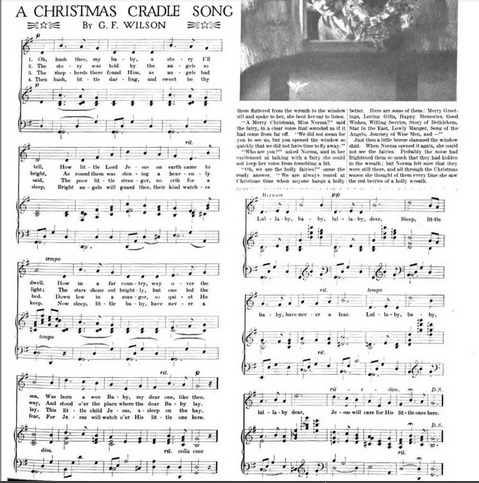
Joseph Ballantyne took Wilson’s words, keeping the title, the first three stanzas and refrain, and composed a new tune which he published five months later in the May 15, 1903 issue of the Juvenile Instructor. [10] This is Ballantyne’s earliest known composition.
“Christmas Cradle Song” was one of Ballantyne’s most popular pieces, and it was reprinted in The Primary Song Book (1905) and every subsequent primary song collection. It also appeared in The Deseret Sunday School Song Book (1909) and was reprinted in the Juvenile Instructor in December 1909. The Children’s Songbook (1989) changed the title to “Oh Hush Thee, My Baby.”
Shine On
Text: M. V. M., 1880; stanzas 2 & 3, 1883
Music: Joseph Ballantyne, 1905
In The Children’s Songbook, both words and music of “Shine On” are credited to Joseph Ballantyne, but in reality he only composed the music. The words were written by another author.
The first stanza appeared anonymously in the February 1880 issue of the Sunday School Journal. [11] The complete song, three stanzas and a chorus set to music by James McGranahan, was published in George F. Root’s Pure Delight (1883). In this book the words were credited to “M. V. M.” [12]
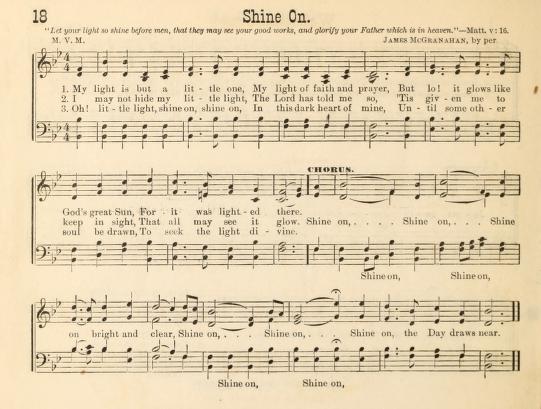
The music credit, “James McGranahan, by per,” suggests that perhaps it was borrowed from another source.
Joseph Ballantyne’s new tune for “Shine On” was first published in The Primary Song Book (1905). [13] It was also included in Deseret Sunday School Songs (1909) and was published concurrently in both collections until 1948. Interestingly, the words were eventually credited to “M. V. M.” in The Primary Songbook, beginning with the 1939 edition, but this attribution was not retained in subsequent primary song collections. [14]
The song was reduced to two stanzas in The Children Sing (1951).
Stand For the Right
Text: Anonymous, 1882
Music: Joseph Ballantyne, 1910
As with “Oh, Hush Thee, My Baby” and “Shine On,” the text of “Stand For the Right” is incorrectly credited to Joseph Ballantyne in The Children’s Songbook. It was originally published anonymously in the October 1882 issue of the Child’s Friend (London). [15]
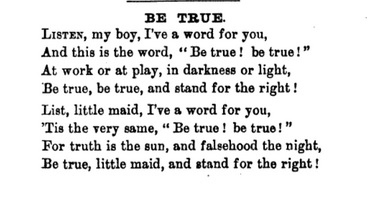
The poem was reprinted in the Juvenile Instructor, May 15, 1906, under the title “The Bird’s Song.” [16] Ballantyne later set this poem to music and changed the title to “Stand For the Right.” It was first published in the Juvenile Instructor, July 1910. [17]
The song remained out of print until it was added to the 1939 edition of The Primary Song Book. [18] It has been included in every subsequent primary song collection. The first line of text was altered to “Our prophet has some words for you” in Sing With Me (1969). The second stanza was removed at the same time.
Biography of Joseph Ballantyne [19]
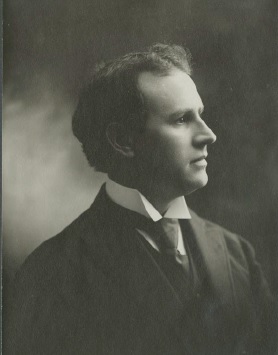
Joseph Ballantyne, date unknown. Photo from the Church History Library.
Portrait of Joseph Ballantyne, https://catalog.churchofjesuschrist.org/assets/29dd3645-c4aa-4673-a804-8ce70de4de61/0/0?lang=eng (accessed: October 9, 2023)
Joseph Ballantyne was born in Ogden Valley, Utah, in a small town named Eden. He was a son of Richard Ballantyne, the founder of the Sunday School program of the Church. It is likely due to the influence of his father that most of Ballantyne’s compositions were written for children.
Ballantyne was educated in the Ogden public schools and in the late 1890s studied music for four years in New York. He spent two years in Europe, studying voice in London under Herman Klein and tenor William Shakespeare.
After returning to Ogden, Ballantyne taught music at the Utah State school for Deaf and Blind. He also taught private voice lessons. In 1900 he reorganized the Ogden tabernacle choir, which had been originally organized in 1856. He directed this choir for twenty-one years and under his direction the Ogden Tabernacle choir became nationally known. The choir first gained attention in 1903 when it performed John J. McClellan’s “Irrigation Ode” at the National Irrigation Congress in Ogden. Two years later the choir was extended a joint invitation to perform at the National Irrigation Congress and at the Lewis and Clark Exposition held at Portland, Oregon. In 1907 the Ogden choir was again invited to sing at the National Irrigation Congress and gave concerts in both Sacramento and San Francisco. By 1913, the Ogden Tabernacle Choir was one of the leading choirs in America and was invited to sing at both the Panama-Pacific Exposition in San Francisco and Panama-California Exposition in San Diego, both scheduled for 1915. The choir spent the next two years preparing for their trip to California. Officially billed as “The ‘Mormon’ Tabernacle Choir of Ogden, Utah,” the choir performed at the San Diego exposition on July 16-18, 1915, and at the San Francisco exposition on July 21-24, 1915.
Ballantyne was appointed director of a male chorus in Ogden in 1921, but just three years later he accepted a position as director of St. Anthony’s Catholic Church Choir in Long Beach, California. For two years, from 1928 to 1930, he also directed the Long Beach Choral-Oratorio Society. In 1933 he started a choir of 250 voices made up of thirteen Latter-day Saint ward choirs in the Long Beach area. He remained in Long Beach until his death on March 19, 1944.
Joseph Ballantye was married to Rosannah Anderson Brown in the Salt Lake Temple in 1886, and they had three children together: Roland Brown Ballantyne, Gladys Bllantyne, and Joseph Earl Ballantyne. [20]
A list of all the known musical compositions of Joseph Ballantyne (in chronological order by publication date) [note: this list may be incomplete]:
Christmas Cradle Song (“Oh, Hush Thee, My Baby”)
[Words by George F. Wilson, 1902]
Juvenile Instructor, May 15, 1903
The Robin and the Pussy Willow (“Two merry little builders”)
“Words Selected.”
[Words by “William Howard Montgomery, 1897*]
Deseret Sunday School Union Kindergarten Plan Book (1904)
—reprinted in the Juvenile Instructor, February 1, 1906
*The words were first published American School Board Journal, April, 1897. The original title was “That Dreadful Cat.”
Summer Time (“Days of summer glory”)
[Words anonymous, ca. 1845*]
The Primary Song Book (1905)
*The words were published as early as 1845 (as “Summer Day,” first line, “Days of summer’s glory”) in Lowell Mason’s Boston School Song Book
Where do all the Daisies go (“Where do all the daisies go”)
“Words from ‘Royal Gifts’”
[Words by Isabella F. Bellows, 1880*]
Juvenile Instructor, August 1, 1905
—reprinted in the Juvenile Instructor, January 1913
*The words were published in the Kindergarten Messenger and the New Education, July 1880
Who Taught the Little Birds? (“Who taught the bird to build her nest”)
[Words anonymous, ca. 1827*]
Juvenile Instructor, August 1, 1905
—reprinted in the Juvenile Instructor, April 1910 (as “Who Taught the Bird?”)
*The words were published as early as 1827 in The Children’s Friend, For the Year 1827
— [Some later sources credit the words to Jane Taylor, but her authorship has not yet been verified]
Jesus Once Was a Little Child (“Jesus once was a little child”)
[Words by James R. Murray, 1880]
The Primary Song Book (1905)
Shine On (“My light is but a little one”)
[Words by M. V. M, 1880; stanzas 2 and 3, 1883]
The Primary Song Book (1905)
Winter Song (“Did you see how the snowflakes came down from above”)
“Words by Jenette B. McKay.”
Juvenile Instructor, February 15, 1906
Spring (“Dear old tree, now tell me”)
[Words anonymous, 1899*]
Juvenile Instructor, March 15, 1906
—reprinted in the Juvenile Instructor, April 1, 1907
*The words were first published in Edward G. Ward’s Rational Method in Reading (1899). It is taken from the poem”Little red bird, tell me.” Stanza two begins: “Dear old oak tree tell me”
God Is Love (“God our father made the night”)
[Words by Patty S. Hill, 1893]
Juvenile Instructor, January 1910
*The words were first published in Song Stories for the Kindergarten (1893). [The link is for 1896 edition]
All the Birds Have Come Again (“All the birds have come again”)
[Words anonymous, ca. 1873*]
Juvenile Instructor, May 15, 1906
*The words were published as early as 1873 in Luther Whiting Mason’s First Music Reader (Boston)
—[Some later sources claim the words are “From the German”]
The Birdie’s Song (“There was once a little, little birdie”)
[Words by Mabel Frost, 1887*]
Juvenile Instructor, October 10, 1906
*The words were first published in Harriet S. Jenks’s Songs and Games for Little Ones (1887)
Pansies (“Little purple pansies, touched with yellow gold”)
[Words by A. E. A., 1899]
Juvenile Instructor, April 15, 1907
Again We Meet Around the Board (“Again we meet around the board”)
“[Words by] Eliza R. Snow,” [1871]
Deseret Sunday School Songs (1909)
Behold, the Great Redeemer Comes (“Behold, the great Redeemer come”)
“[Words attributed to] P. P. Pratt,” [1840]
Deseret Sunday School Songs (1909)
Come, Follow Me (“’Come follow me!’ the Savior said”)
“[Words by] John Nicholson,” [1871]
Deseret Sunday School Songs (1909)
The Alder by the River (“The alder by the river”)
[Words by Celia Thaxter, 1872*]
Juvenile Instructor, March 1910
*The words were first published in Poems by Celia Thaxter (1872)
A River Song (“A shining little river”)
[Words anonymous*]
Juvenile Instructor, May 1910
*I haven’t been able to find these words in any other source.
Stand For the Right (“Listen, my boy, I’ve a word [f]or you”)
[Words anonymous, 1882]
Juvenile Instructor, July 1910
Morning Song (“Morning awaketh, darkness is gone”)
[Words anonymous, ca. 1883*]
Juvenile Instructor, August 1910
*The words appear as early as 1883 in an article by Lucy Wheelock, “reprinted from Barnard’s American Journal of Education for 1883.” It also indicates the words are “From the German.”
Utah Fairest Utah (“Sweet native land, of thee I sing”)
[Words anonymous, 1905*]
Juvenile Instructor, September 1910
*The words were first published in the Salt Lake Tribune, October 1, 1905
Little Brown Leaf (“A little brown leaf as it fell to the ground”)
[Words by Lilla Thomas Elder, 1905*]
Juvenile Instructor, September 1910
*The words were first published in the Youth’s Companion, April 13, 1905
–The words were also published in Lilla Elder’s posthumous collection, Lilacs in the Wood (1907)
Thanksgiving Song (“The happy Thank you day has come”)
[Words by D. H., 1895*]
Juvenile Instructor, October 1910
*The words were first published in Child-Garden of Story, Song, and Play, November 1895. The identity of “D. H.” is not known.
God Sees All (“When the winter snowflakes fall”)
[Words by Julia Willoughby, 1872]
Juvenile Instructor, January 1911
*The words were first published in Little Folks: a Magazine for the Young, Vol.2, no. 60 (1872), signed “J. W.”—The author’s identity was established based on the discovery that another poem signed “J. W.” in Little Folks, “The Death of Sir Philp Sidney (1586)” [“On the Death of Philip Sidney”] also appears in her Julia Willoughby’s collection A Child’s Poetic Thoughts (1868)
Sacramental Song (“Heavenly Father while we eat”)
“[Words by] Wm. A. Morton,” [1913]
Juvenile Instructor, March 1913
Officer’s Song (“We are a band of workers true”)
“Words by Nora Cotter,” [1913]
Children’s Friend, May 1913
God Made the Sky that Looks so Blue (“God made the sky that looks so blue”)
[Words anonymous, ca. 1820*]
Juvenile Instructor, October 1913
*The words may have been first published in The Mother’s Gift “By a Lady.” This book has been dated ca. 1820, but this date is uncertain: there is no date printed in the book.
—It was titled “Gratitude” in The Primary Song Book (1939)
Mother (“Her gentle presence filled a home”)
“Words by Louis W. Larsen,”[1912*]
Juvenile Instructor, April 1914
*The words were first published in the Young Woman’s Journal, May 1912
Jesus Bids Us Shine (in Japanese)
[Words by either Susan B. Warner or Anna B. Warner, 1862*]
The Songs of Zion: a collection of choice songs especially selected and arranged for the home and all meetings, sunday schools and gatherings of elders and saints in the mission field (Tokyo, Japan: Japan Mission of the Church of Jesus Christ of Latter-day Saints, 1915), 215
*The English words of this song were first published anonymously in the Little American, October 1 1862
[Note: I have not yet examined the “Joseph Ballantyne scrapbook, 1905-1940” (MS 34623) at the Church History Library which may have other compositions than those listed above.]
Notes:
[1] see James R. Murray, Dainty Songs for Little Lads and Lasses (Cincinnati: John Church Co., 1887), 110
[2] James R. Murray, Royal Gems: A New and Choice Collection of Sunday School Songs (Cleveland: S. Brainard’s Sons, 1880), 70
[3] The Primary Song Book (1905), 16
[4] Biographical sketch of James R. Murray:
James Ramsey Murray was born in 1841 in Ballardvale, Massachusetts, a village located within the town of Andover. His parents, Walter and Christine Morrison Murray, came to American from Scotland in 1840. James received his education in the public schools of Andover, and was first employed by the Tyler Rubber Company. He displayed musical talent at an early age and later attended George F. Root’s Musical Institute at North Reading, Massachusetts, where his music instructors included Root, William B. Bradbury and Lowell Mason.
He enlisted in the Union army when Civil War broke out. His first composition to enjoy popularity was “Daisy Deane,” composed in 1863 when he was in Virginia. The words were supplied by his cousin Thomas F. Winthrop, who was serving there with him.
When he returned home after the war, he taught piano in Andover for a time, but gave up teaching to accept a position with the Root & Cady publishing company in Chicago as editor of The Song Messenger. He also assisted in the writing and publishing department.
On May 11, 1868 he married Isabella Maria Taylor, whom he had known from childhood. They had three children, only one of whom, Winthrop Root Murray, lived to adulthood. While in Chicago, Murray became interested in the teachings of Emanuel Swedenborg and joined the New Church (Church of the New Jerusalem). He remained active with this denomination for the remainder of his life.
After the great Chicago fire of 1871, Murray and his wife moved back to Andover, where he taught music and played organ at the Old South Church.
In 1881 Murray accepted a position with the John Church Company in Cincinnati, Ohio, taking charge of the publishing department and editing the Musical Visitor. Murray died in Cincinnati on March 10, 1905.
Murray was the editor of several song books. The most popular of these were The Prize (1870), Pure Diamonds (1872), and Royal Gems (1880).
Sources:
* L. P. M, “Obituary: Murray,” New-Christian Messenger 88, no. 15 (April 12, 1905): 209
* J. H. Hall, Biography of Gospel Song and Hymn Writers (New York: Fleming H. Revell Company, 1914), 209-210
* “Biographies: James R. Murray, 1841-1905,” Library of Congress, Accessed January 16, 2023
[5] “A. E. A., “Pansies,” Primary Education 7, no. 7 (September 1899): 325
[6] Biographical sources for Alice E. Allen:
- “United States Census, 1900,” database with images, FamilySearch (https://www.familysearch.org/ark:/61903/1:1:MSNY-SJ3 : Thu Oct 05 16:16:40 UTC 2023), Entry for Henry E Turner and Cornelia E Turner, 1900.
*“Miss Alice E. Allen to Retire as Librarian,” Watertown (New York) Daily Times, November 1, 1951, 8
* “Lewis,” The Bookmark 19, no. 6 (March 1960):167
* “ Alice E Allen” in the “New York State, U.S., Death Index, 1957-1970,” Ancestry.com, database (no image), accessed October 15, 2023 - “North America, Family Histories, 1500-2000 for Alice E Allen, Daughters of the American Revolution Lineage Book : NSDAR : Volume 089 : 1911,” Ancestry.com, database with image, accessed October 15, 2023
[7] Joseph Ballantyne, “Pansies,” Juvenile Instructor 42, no. 8 (April 15, 1907): 249
[8] Biographical Sources for George F. Wilson:
* “Changes in Wakefield,” Boston Evening Transcript, September 3, 1912, 12
* “George F. Wilson of Wakefield Dead,” Boston Globe, October 5, 1921, 5
* “Massachusetts State Vital Records, 1841-1925,” database with images, FamilySearch (https://www.familysearch.org/ark:/61903/1:1:6ZXZ-J18D : 16 November 2022), George F Wilson, 1921.
[9] G. F. Wilson, “Christmas Cradle Song,” Primary Education 10, no. 10 (December 1902): 496
* Page 504 of this same issue of Primary Education indicates that Mr. G. F. Wilson lived at 310 Main Street, Wakefield, Massachusetts
* Wilson’s song was reprinted in the Youth’s Companion, December 14, 1916, with full piano accompaniment.
[10] Joseph Ballantyne, “Christmas Cradle Song,” Juvenile Instructor 38, no. 10 (May 15, 1903): 306
* Wilson is not credited with the words in the Juvenile Instructor.
[11] “Whisper Songs for February,” Sunday School Journal 12, no. 2 (February 1880): 48
[12] George F. Root, Pure Delight: A Collection of Songs and Services for Sunday Schools (Cincinnati: J. Church & Co., 1883), 18
[13] The Primary Song Book (Salt Lake City, 1905), 26
[14] The Primary Song Book Including Marches and Voluntaries (Salt Lake City, 1939), 90
[15] “Be True,” Child’s Friend (London), October 1882, p. 159
[16] “The Bird’s Song,” Juvenile Instructor 41, no. 10 (May 15, 1906): 314
[17] Joseph Ballantyne, “Stand For the Right,” Juvenile Instructor 45, no. 7 (July 1910): 365
[18] The Primary Song Book Including Marches and Voluntaries (Salt Lake City, 1939), 17
[19] Joseph Ballantyne’s middle initial is given as “W.” on both his death certificate and in an obituary published in the Long-Beach Press Telegram, but it is not known what this letter stands for. His name does not appear with a middle name or initial in any other known source.
[20] Biographical Sources for Joseph Ballantyne:
* Alonzo West, “The Tabernacle Choir of Ogden, Utah,” Juvenile Instructor 50, no. 8 (August 1915): 501-506
* Tyndall Gray, “Ogden Tabernacle Choir Takes San Diego By Storm,” Musical Courier 71, no. 5 (August 5, 1915): 8
* Musical Courier 71, no. 13 (September 30, 1915): 20
* “Male Chorus Formed Here,” Ogden Standard-Examiner, December 24, 1921, 8
* “Local Musicians Appear in Long Beach Programs,” Musical America 40, no. 4 (May 17, 1924): 34
* “Long Beach Events,” Musical America 48, no. 22 (September 15, 1928): 23
* “Long Beach Programs,” Musical America 50, no. 19 (December 10, 1930): 36
* “Outdoor Theatre Dedicated in Long Beach,” Musical America 53, no. 10 (May 25, 1933): 51
* “Choir Leader Rites Pending at Ogden,” Salt Lake Telegram, March 22, 1944, 16
* “Death Calls Former Leader Of Tabernacle Choir,” Ogden Standard-Examiner, March 20, 1944, 10
* “Ballantyne, Noted Choir Leader, Dies,” Long Beach Press-Telegram (Long Beach, California), March 20, 1944, 8